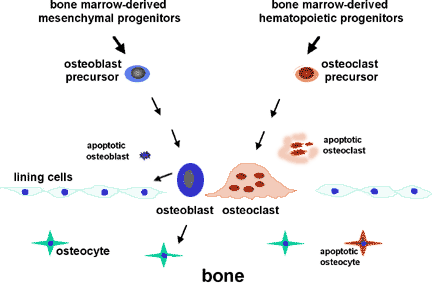Last Updated on May 31, 2020
A cell is a basic building unit of any tissue or organ. Bone cells constitute bone tissue which are arranged to form the structure we see outwardly.
Following types of bone cells are found in the bone.
- Osteoclasts
- Osteoblasts
- Osteocytes
- Lining cells
Different types of bone cells are programmed for kinds of functions.
Osteoclasts
The osteoclasts are a very large multinucleate giant bone cell attached to the bone surface. It has 15-20 nuclei and may measure several hundreds of micrometers across. These bone cells are responsible for the resorption of living bone.
Osteoclasts are derived from hemopoietic precursor cells, probably a circulating monocyte of the macrophage type.
Precursors of osteoclasts circulate in the blood and bone marrow. Mature osteoclasts are formed from the fusion of the precursors.
This maturation occurs when RANK receptors on the osteoclast precursors are activated by the RANK-ligand secreted by osteoblasts.
Morphologically, the nuclei of osteoclasts are frequently indented with prominent nucleoli. Mitochondria are numerous and there are little rough endoplasmic reticulum and many lysosomes.
Infolded plasma membrane, termed the ruffled border is an important feature. It is surrounded by an organelle-free clear zone through which the osteoclast attaches to the bone and which is the site of bone resorption.
Osteoclasts contain the characteristic enzymes tartrate-resistant acid phosphatase (TRAP) and carbonic anhydrase.
Osteoclasts resorb the bone. The bone mineral is probably dissolved in the acid environment. Osteoclasts do not produce collagenase (which is, in fact, synthesized by osteoblasts). They probably break down the bone matrix by the release of lysosomal proteases.
For their action, osteoclasts form sealed compartments next to the bone surface. These cells then secrete acids and enzymes which degrade the bone. After they finish resorbing bone, they undergo apoptosis. Apoptosis is a kind of programmed cell death and is well regulated by proteins from other cells.

Osteoblasts
Osteoblasts are cuboid-shaped mononuclear bone cells. Osteoblasts are 15-30 µm in length. These bone cells form a continuous monolayer over the surface of the bone. Osteoblasts are derived from marrow stromal cells by differentiation of pre-osteoblasts.
The osteoblasts themselves do not divide.
These bone cells have a single nucleus in contrast to multiple nuclei contained in osteoclasts.
This nucleus is eccentrically placed and contains abundant rough endoplasmic reticulum. Abundant rough endoplasmic reticulum is a characteristic of a cell engaged in protein synthesis. There is also a high level of alkaline phosphatase. Vesicles containing amorphous calcium phosphate may also be present.
These bone cells are connected together and to the processes of subjacent osteocytes by gap junctions. Inactive bone surfaces are lined by a monolayer of flattened cells which are thought to be resting osteoblasts.
The osteoblasts are responsible for the synthesis of the major proteins of bone including type I collagen and the non-collagenous proteins of bone such as osteocalcin (bone Gla protein) and osteonectin.
These bone cells are also involved in the mineralization of bone and produce the enzyme alkaline phosphatase, which may be important for this.
Recent evidence suggests that the osteoblast plays a central role in controlling osteoclastic function.
Osteoblasts and not osteoclasts have specific surface receptors for agents that stimulate bone resorption, such as 1,25-dihydroxy vitamin D3 and parathyroid hormone.
Osteoblasts also secrete PHEX, a protein that helps to regulate the amount of phosphate excreted by the kidney.
Collagenase secreted from the osteoblast may also play a role either physically preparing the bone surface for attachment of the osteoclast or by allowing releases of an osteoclastic activating or chemotactic factor which is secreted within the bone, such as transforming growth factor-beta.
When the team of osteoblasts has finished making new bone, some become surrounded with matrix and differentiate into osteocytes. Others will remain on the surface of the new bone and differentiate into lining cells. The rest undergo apoptosis and disintegrate.
Osteocytes
These are the bone cells that live inside the bone and have long branches which allow them to contact each other as well as the lining cells on the bone surface. They sense mechanical strain on the bone and can secrete growth factors to activate the lining cells or stimulate the osteoblasts.
The osteocytes are thought to direct bone remodeling to accommodate mechanical strain and repair fatigue damage.
Lining cells
These bone cells are former osteoblasts which have become flat and pancake-shaped and line the entire surface of the bone. They are responsible for the immediate release of calcium from the bone if the blood calcium is too low. They also protect the bone from chemicals in the blood which dissolves crystals (such as pyrophosphate).
They also have receptors for hormones and factors that initiate bone remodeling.
Other Bone Cells
The reticular cells which are found within the mesh-like stroma of the bone marrow, and possess both osteogenic and hemopoietic capabilities.
The endosteal cell may be connected tissue cells or resting osteoblasts and fibroblasts with basophilic cytoplasm and round nucleus.
Interplay of Bone Cells in Bone Dynamics
The bone acts to support the tissues, viscera, and nervous system. It also acts as a lever for muscle actions.
Bone is living tissue and to avoid fatigue bones undergo continuous resorption carried out by osteoclasts and formation by osteoblasts.
The two processes are in continuous balance to keep the bone constant.
In children, the bone formation is more than the resorption to achieve growth.
In old age and in some bone diseases resulting in more resorption than formation, osteoporosis results.
It is not clear how these bone cells interact with each other but it is shown that mature osteoblasts and mature osteoclasts have dynamic communication to achieve the homeostasis of bone tissues.
References
Masayuki Furuya et al. Direct cell–cell contact between mature osteoblasts and osteoclasts dynamically controls their functions in vivo, Nature Communications (2018). DOI: 10.1038/s41467-017-02541-w